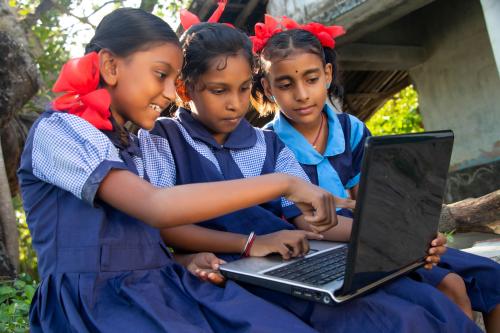This is the first blog in a series on strategies to transform how education is delivered in India in response to the COVID-19 pandemic.
The pandemic has presented a myriad of challenges across education systems globally, but it also presents the opportunity to take advantage of this disruption and make fundamental shifts about how we educate our children. The Indian education system caters to 250 million school children—some who have been out of school for almost two years. As the world gears up to recover from the pandemic, understanding what works in India could generate proof points of what works with other diverse populations at scale.
To learn more about this, I spoke with the co-managing director of the Central Square Foundation, Shaveta Sharma-Kukreja, who is based in India and has two decades of professional experience in education and management. She leads the foundation’s work on foundational literacy and numeracy across state engagement and classroom instruction and also oversees the foundation’s organizational development and grantmaking.
1. Together with 15 other nongovernmental organizations in India, your organization has collaborated on developing a shared education agenda for transforming the Indian education system out of COVID-19. Can you share with us why these groups came together and what you hope to accomplish?
The second wave of COVID-19 early last year created an unprecedented crisis in India. While both state and central governments had worked tirelessly to ensure learning continues at home through digital means, the solutions fell short and were seen as a temporary fix until students could return to school. Because there is a growing consensus among experts in the education sector that the next couple of years will be ridden by intermittent school closures with multiple COVID waves, the education system needs to build digital capacity to reduce the impact on student learning. Doing so would also allow us to integrate at-home learning to augment school learning more systematically.
Keeping this in mind, we at Central Square Foundation brought 15 different organizations working in the education sector in India together to align on a shared vision for transforming education post-COVID. The purpose was not only to align on a common goal but also to rally all the resources in the same direction to minimize learning loss due to COVID and ensure gains for all students in an uncertain future.
This effort culminated in a policy report that highlights 10 key recommendations to build education back better post-COVID.
2. What are the main problems this coalition of actors is hoping to address?
There are three main problems the coalition of actors is hoping to address in the future.
Loss of skills due to lost instructional time during school closures. Children have missed what they would have learned had schools remained open and forgotten what they had known before they shut down. In fact, a study by Azim Premji University suggests that 92 percent of children have lost at least one language-related ability, and 82 percent of children have lost at least one mathematical-related ability from previous grades due to COVID-related school closures. Short-term fixes clearly won’t be sufficient in bringing students back to grade level, and India needs a long-term strategy to begin to remedy all of the lost instructional time.
A potential challenge of continued disruptions even after schools reopen. Epidemiologists worldwide have predicted multiple, resurgent waves of COVID until a considerable population is immune. This is currently being evidenced with the rise in COVID cases globally, especially in the younger age groups who are yet to be vaccinated. Therefore, we believe any education solution cannot exclude the possibility of future disruptions, and the system needs to be resilient enough to cope with these uncertainties.
Increased inequity in access to education. Over the past few decades, India made significant progress in getting almost 100 percent of eligible children enrolled in primary schools. The pandemic, however, greatly reversed this progress. Studies suggest that a significant number of children, especially those from marginalized groups, are at risk of dropping out of school due to displacement and economic deprivation, pushing children into child labor and early marriages due to the pandemic. There is an urgent need to address this inequity in accessing education as schools reopen.
3. Why do you feel now is the time to leapfrog in education in India, and how is the coalition proposing to do that?
The pandemic was nothing short of a wake-up call for all of us. Never have we witnessed global school closures spanning months and even years in some regions. Even pre-pandemic, half of India’s children suffered from learning poverty and struggled to attain foundational literacy and numeracy. This is proof that our education system in its current form was failing our children even before the pandemic, and the pandemic has only widened the gap.
Fortunately, the pandemic also gave us a strong reason to step back, think, and plan. As a coalition, we believe a few fundamental shifts are required to build our education system back better:
- Focus on foundational skills. Foundational literacy and numeracy are the gateway skills that help children acquire higher-order thinking skills in the future. Therefore, we need to prioritize and ensure all children can read and do basic math irrespective of their age and grade.
- Restructure what children are learning and how they are learning. Along with foundational skills, prioritize and identify what is most important to learn and reorient the curriculum to just that. Continuously assess children’s learning to determine where they are and then meet them at their level versus teaching content they might not be fully grasping.
- Redefine the role of teachers and mentors. The role of the teacher is no longer limited to the four walls of the classroom. Digital and at-home learning redefined the role of teachers as facilitators, and they need to be reoriented to their new roles. Likewise, it is essential that teachers have mentors to support continuous professional development on the job and help them stay motivated.
- Build parent capacity to support at-home learning. Learning is no longer limited to schools, and the role of parents has become even more critical during the pandemic. Parents need to be supported with tools and resources to help their children continue to learn at home and minimize the impact of any unforeseen future disruptions.
I hope that the lessons learned and solutions attempted through the pandemic can help us design a more integrated and resilient approach to ensure all children—in India and around the world—are set up for better learning and better futures.
The Brookings Institution is committed to quality, independence, and impact.
We are supported by a diverse array of funders. In line with our values and policies, each Brookings publication represents the sole views of its author(s).









Commentary
Why Indian NGOs are developing a shared education agenda in reaction to COVID-19
Interview with Shaveta Sharma-Kukreja
January 19, 2022